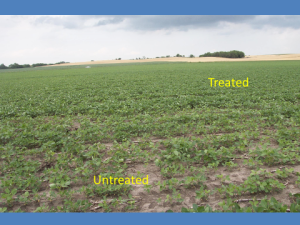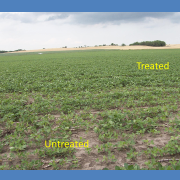Why Gypsum Works in Your Soil: Part 3 Gypsum Improves Alkali soils
 Gypsum has been used for centuries to reclaim sodium affected soils (alkali soils). It is effective since it has good solubility regardless of soil pH. In fact, its solubility is enhanced in sodic soils. Some data would suggest that the solubility of gypsum in alkali soils is four times greater. Once the gypsum dissociates into calcium and sulfur the calcium has the greatest attraction for the soil particle displacing sodium. The calcium will help flocculate (aggregate) the soil whereas the sodium on the soil causes dispersion. This means that calcium from the gypsum will improve soil structure and improve plant growth.
Gypsum has been used for centuries to reclaim sodium affected soils (alkali soils). It is effective since it has good solubility regardless of soil pH. In fact, its solubility is enhanced in sodic soils. Some data would suggest that the solubility of gypsum in alkali soils is four times greater. Once the gypsum dissociates into calcium and sulfur the calcium has the greatest attraction for the soil particle displacing sodium. The calcium will help flocculate (aggregate) the soil whereas the sodium on the soil causes dispersion. This means that calcium from the gypsum will improve soil structure and improve plant growth.
It is important that you apply the proper rate of gypsum based upon soil tests to see the best responses. We have found that higher rates of gypsum need to be applied if you have sodium present plus high levels of magnesium, since both minerals will cause dispersion of the clay particles. If you have this condition and need assistance in what rate to apply please give us a call.
How fast your soil structure is restored depends upon how high your levels of sodium in the soil are. Typically, you will see a quick change in soils and less water ponding, however, as plants begin to grow in these soils you will see biological activity return and gradually improve with each growing season. Remember, your soil did not get to this point in one growing season. You can’t expect the soil to be reclaimed in one growing season. However, the picture to the right was taken from a field where PRO CAL 40 gypsum was applied in the spring prior to planting the soybeans. You can see that there was a marked improvement in the soybeans where treated.
If subsurface drainage is a problem installing drainage tile will help flush the sodium from the soil profile. Gypsum applied to the surface will reduce the surface sealing in these soils and improve the effectiveness of the drainage tile.
Once calcium levels are restored to an optimum range of 75% base saturation, the soil structure will improve, the root development will be larger and yields will be closer to the field average.




